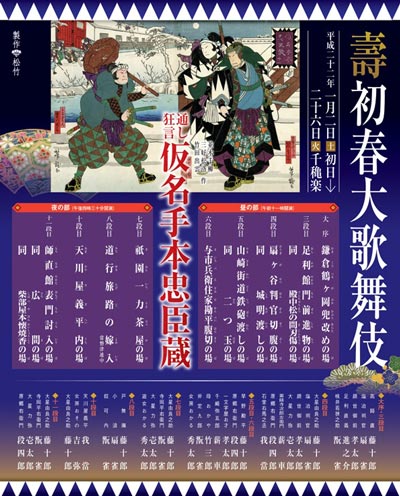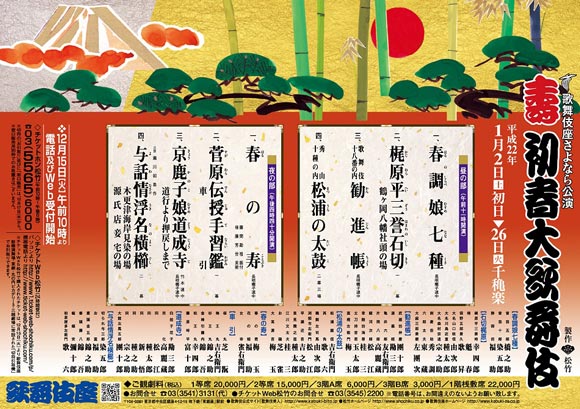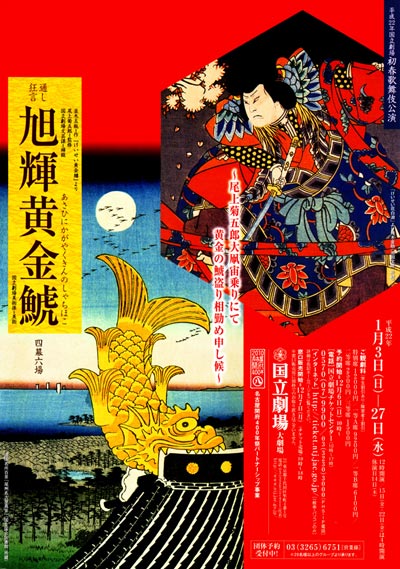| Comments |
The play "Kanadehon Chűshingura" (The Treasure of 47 Loyal Retainers) is the most
popular in the Kabuki repertory and is known throughout the world.
This t˘shi ky˘gen new year production includes the rarely-staged "Amakawaya Gihei Uchi" act.
Kabuto Aratame/Shinmotsu/Ninj˘: daimy˘ lords from around the country
gather for an important ceremony in the presence of Tadayoshi, the younger brother
of the Sh˘gun. Under the watchful eye of the official Moron˘ (Sakata T˘jűr˘),
lords En'ya Hangan (Nakamura Senjaku) and Wakasanosuke (Nakamura Kanjaku) have been charged
with making sure everything goes according to protocol. En'ya Hangan's wife Kaoyo
(Kataoka Takatar˘) is asked to identify a helmet to be used in the ceremony.
Moron˘ is in love with Kaoyo and tries to woo her, but Wakasanosuke stops him.
In return, Moron˘ uses his position of authority to berate the young lord and
Wakasanosuke decides to kill Moron˘. But the next morning at the Sh˘gun's mansion,
Wakasanosuke's head retainer bribes Moron˘ to keep his master from causing an
incident and although Wakasanosuke is about to attack Moron˘, the aged official
groveling stops him. As a result, though, Moron˘ is frustrated and angry and
vents his feelings on En'ya Hangan, especially after Hangan innocently brings him
a letter in which Kaoyo refuses Moron˘'s love. Moron˘ steadily insults Hangan,
who tries to ignore the pressure, but finally draws his sword and attacks.
Drawing a sword in the Sh˘gun's palace is a crime punishable by death,
but Moron˘ himself escapes with only a slight wound as others within
the mansion hurry in to stop Hangan.
Hangan Seppuku/Shiro Akewatashi: emissaries from the Sh˘gun arrive at
En'ya Hangan's mansion to announce that he has received the strictest penalty for
his actions. He is ordered to commit ritual suicide and his household is to be
disbanded. Hangan's hate for Moron˘ grows when he hears that Moron˘
has received no punishment. Hangan waits and waits for his head retainer,
but he does not arrive. Finally, Hangan plunges in the blade.
At that moment, his head retainer Yuranosuke (Sakata T˘jűr˘) arrives from their home
province. With his last breaths, Hangan gives Yuranosuke the knife he used to
commit suicide and tells him to take revenge. Now that the clan has been disbanded,
Hangan's men become masterless samurai. Though some urge an immediate attack on
Moron˘, Yuranosuke bids them not to do anything rash. When alone in front of the
closed mansion gates, though, he secretly reveals his determination that his
lord will not have died in vain. Featuring Kataoka Gat˘ and Band˘ Shinsha in the roles of
Ishid˘ Umanoj˘ and Yakushiji Jirozaemon.
Tepp˘ Watashi/Futatsudama/Kanpei Harakiri: Kanpei (Sakata T˘jűr˘) lives a
poor life with Okaru (Kataoka Hidetar˘) at her parents' rural home. Kanpei desperately
wants to take part in the vendetta against Moron˘, but must come up with the
money necessary to finance his part in it. Secretly, Okaru and her family
decide that the only way to raise the money is to sell her to the pleasure quarters.
On a lonely highway, a highway thief named Sadakur˘ (Nakamura Kanjaku) kills her father
while he is on the way home from sealing the deal and the money is stolen. In a
bizarre twist of events, Kanpei kills the robber while hunting on a dark night
and finds the money. The fabric of the wallet, though, seems to prove that he
has murdered his father-in-law. Kanpei commits ritual suicide to take
responsibility, not only for the death of this father-in-law, but also
for being absent when his lord needed him most.
Gion Ichiriki Jaya: Yuranosuke (Sakata T˘jűr˘) spends his days and nights
in the pleasure quarters of Ky˘to in an effort to make Moron˘ believe he is not
planning a vendetta. His acting is so good that even men in his own group believe
he has given his life up to pleasure. Moron˘ is not so easily convinced, though,
and has sent spies, including a former retainer of En'ya Hangan, to find
Yuranosuke's true intentions. Yuranosuke finds himself tested to the limits
by the spy, and is even forced to eat meat on the anniversary of Hangan's death,
a strong taboo. Okaru (Kataoka Hidetar˘), now a courtesan, is also at the Ichiriki
Teahouse. She catches a glimpse of a letter to Yuranosuke detailing plans for
the vendetta, but he sees her and offers to buy out her contract, knowing he
must kill her to keep the vendetta a secret. Okaru's brother Teraoka Heiemon (Nakamura Kanjaku),
a servant in the Hangan household, has also come to the teahouse and when he
hears that Yuranosuke is to buy out her contract, he realizes his true intentions.
Heiemon tries to convince Okaru to let him kill her as such an act may allow
him to take part in the vendetta as well. Hearing that Kanpei is now dead,
Okaru agrees, but observing their loyal actions, Yuranosuke spares Okaru and
allows Heiemon to join the vendetta.
Michiyuki Tabiji no Yomeiri: this is a short dance scene that shows Honz˘ĺs wife Tonase (Sakata T˘jűr˘)
and her daughter Konami (Nakamura Senjaku) traveling along the T˘kaid˘ highway to Ky˘to
on a desperate journey to unite her with Rikiya. The beauty of the journey and innocent happiness of
the young bride contrast with the anxious feelings of the mother, aware that this trip
will end in tragedy. There is also a humorous encounter with a boisterous samurai
footman (Nakamura Kanjaku).
Amakawaya Gihei Uchi: Yuranosuke (Sakata T˘jűr˘) has involved Amakawaya Gihei (Kataoka Gat˘), a merchant, in the vendetta so as to assemble weapons for the raid.
Gihei has sent his wife (Kamimura Kichiya) to her father-in-lawĺs home so as to prevent her from knowing of his involvement.
His father-in-law pesters him to divorce her so that he can marry her off to a wealthy man. At this moment some of
Yuranosukeĺs men arrive to test Giheiĺs loyalty. Even when they threaten to kill his infant son unless he confesses
the location of the weapons, Gihei remains steadfast. Yuranosuke then reveals himself and the fact that Gihei has passed the test.
Yuranosuke abruptly cuts off the hair of Giheiĺs wife and declares to the father-in-law that she cannot be married off because
she has become a nun.
Uchiiri/Hiroma/Shibabeya: disguised as firemen, En'ya Hangan's
retainers attack Moron˘'s mansion on a snowy night. After a fierce fight, they
find Moron˘ hiding in a charcoal shed and take revenge for their lord's wrongful
death.
Source: Earphone Guide website, except "Amakawaya Gihei Uchi" (Paul Kennelly)
|




